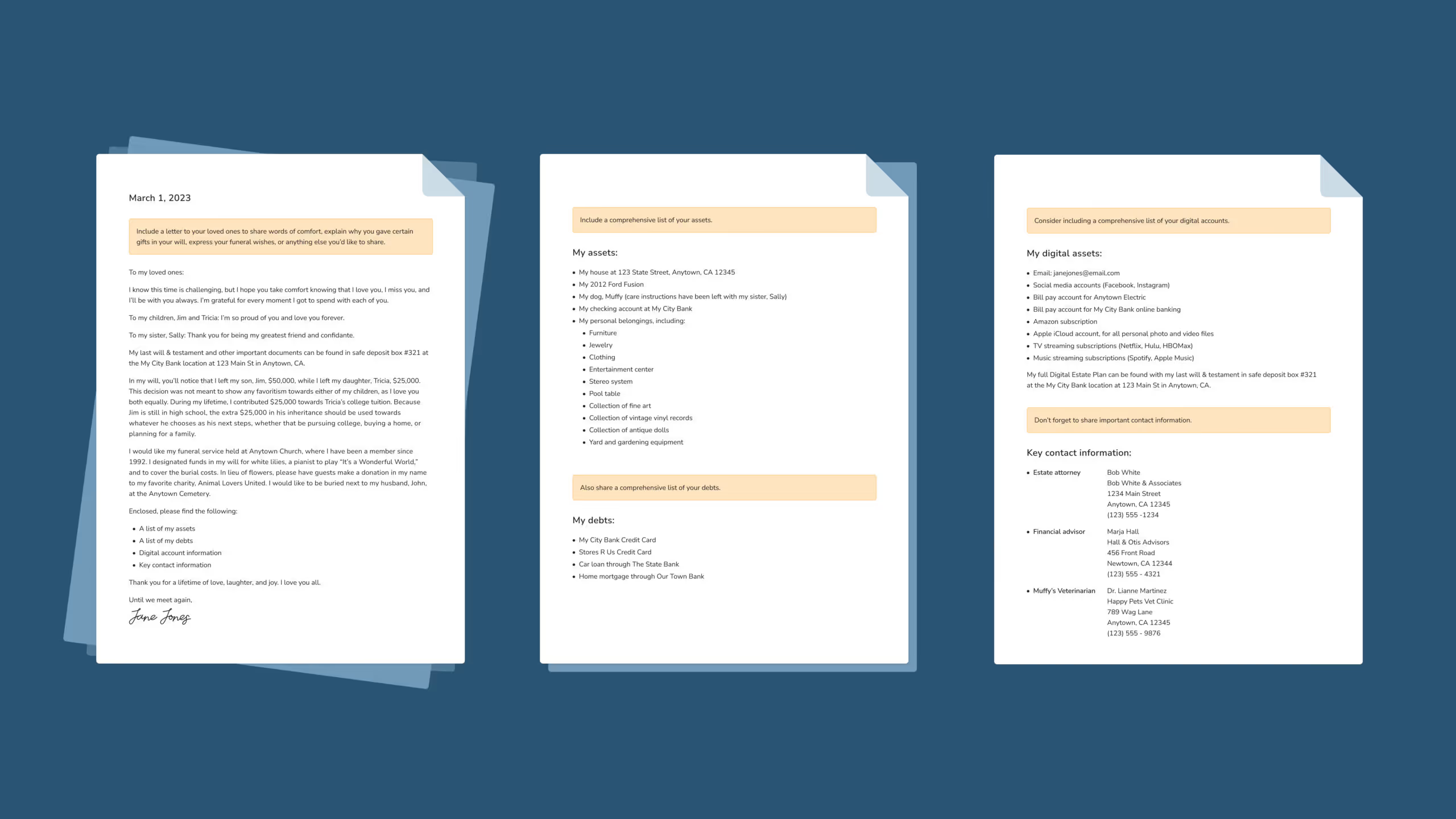Your last will and testament is an essential legal document that contains a lot of information. It uses complex language to outline who should manage your affairs when you pass away, what should happen to your property, and who should look after your children.
What your will doesn’t contain are simple explanations about why you made certain decisions, details on where to find certain people or accounts, or messages to your loved ones.
To share this information, you need a letter of instruction.
What is a letter of instruction?
A letter of instruction is a document in which you share your final wishes in plain terms. A letter of instruction isn’t legally binding, like your will. Instead, you use it to explain the choices you made in your will, share your funeral wishes, and offer final messages of comfort to the people who mean the most to you.
Letters of instruction can also be a “cheat sheet” for important details that aren’t in your will. This includes where your key documents are (like your life insurance policy or Social Security card), contact information for your estate attorney or financial advisor, or care instructions for your pet.
Letter of instruction vs. last will & testament: What’s the difference?
Wills and letters of instruction are important parts of your estate plan that each serve a unique purpose.
A last will and testament is a legal document you use to share how you want your property distributed when you pass away. Wills use formal language and are legally-binding documents.
A will is especially important during the probate process. Probate is the legal process of distributing your estate according to your will. If you die without a will (known as dying intestate), your assets will be distributed according to a set of arbitrary rules called intestate succession laws. Without a will, the court will consider your estate to be intestate, even if you have a letter of instruction.
A letter of instruction is not a legal document. It’s a way to share information with your loved ones in easy-to-understand language. Letters of instruction have no set structure, and you can update them at any time without having to sign them in front of witnesses or take steps to make them legally valid.
Letters of instruction can’t replace a valid will. Instead, they work alongside your will to explain your wishes, provide extra information, and leave final messages for your loved ones.
Why do you need a letter of instruction?
You can use a letter of instruction to:
- Explain your final wishes. In your letter of instruction, you can explain the decisions made in your will, like why you left certain assets to certain people and why you chose a specific person to care for your minor children or pets. This can help clear confusion and prevent arguments between loved ones when you’re gone.
- Leave a message for loved ones. A letter of instruction is a meaningful way to leave words of comfort or wisdom for your loved ones. This could be a final personal message to individual people, or a note to a charitable organization about what their mission means to you. If you have minor children, you can include information or advice you’d like to share with them when they’re older.
- Provide important information. This could include contact information for an estate attorney or financial advisor, the location of important documents, and private details about personal or financial accounts.
- Share your funeral wishes. Your letter of instruction can include directions for your funeral, including where you want it held, what flowers or music you want, and whether you want to be buried or cremated. If you don’t want a funeral or memorial service, you can share that in your letter.
How to write a letter of instruction
There’s no right or wrong way to write a letter of instruction — it’s completely up to you!
To help you get started, we’ve broken down what you should (and shouldn’t) put in your letter of instruction:
What to include in your letter of instruction
Here are some of the most common things to consider including in your letter of instruction:
- Personal messages. You can use your letter of instruction to leave final messages, advice, or words of comfort or encouragement to your loved ones.
- Instructions for your executor. An executor manages your estate after you pass away. If you have any special instructions about how your executor should handle certain assets or important information they should know, you can include this in your letter.
- List of assets. Including an asset inventory can help save your executor time, because they won’t have to try to track down all of your assets.
- List of debts. Leaving a list of debts can also help save your executor time when settling your estate.
- Where to find important documents. Your letter should mention where your loved ones can find your estate plan, property titles, life insurance policies, retirement account forms, birth certificate, social security card, and any other essential documents.
- Contact information. It’s helpful to include contact information for your estate attorney, financial advisor, investment firms, insurance agent, or any other professional advisors you hired during your lifetime.
- Reasons behind asset distributions. In your letter, you can share why you decided to leave certain assets to certain people or explain any unequal distributions. For example, maybe you paid for your older child’s college tuition during your lifetime, so you decide to leave more to your younger child to cover their future college costs.
- Funeral or burial wishes. You can include your funeral wishes in your letter of instruction, like what type of service or celebration you want, if you prefer to be buried or cremated, and if you’d like donations made to a specific charity in your honor.
- Care plans for minor children or pets. If you have minor children or pets, your letter of instruction can share instructions for their care. This could include listing contact information for their primary doctor or vet, any medications they take, and any allergies they may have. You can also share your wishes for your child’s future or leave a special message for when they reach a certain age or milestone.
- Digital account information. The average person has over 160 digital accounts to their name, including email, social media, financial accounts, online storage accounts, and so much more. Your letter of instruction can include a list of digital assets and the location of your digital estate plan.
What not to include in your letter of instruction
You can include anything you want in your letter of instruction — but that doesn't mean you should. Because a letter of instruction isn’t legally binding, you shouldn’t put instructions for how you want your assets distributed after you pass away. You should save this for your will document.
Sample letter of instruction

How to update a letter of instruction
Because it’s not a legal document, there’s no formal process for updating your letter of instruction. You can change, add, or remove information at any time.
It's a good idea to regularly review your estate planning documents (including your letter of instruction) to make sure they’re current. Experts recommend updating your documents every three to five years, or whenever you experience a major life change, like buying a house or having a baby.
Where to store your letter of instruction
Once you’ve written your letter of instruction, you should store it in a safe place with the rest of your estate planning documents. This could include:
- A waterproof, fireproof box or safe
- A safe deposit box
- With your will executor
- With your estate attorney
- With your local probate court
Be sure to let someone know where your estate planning documents are stored. If you don’t, your loved ones may not be able to find them.
Protect your estate with a will
A letter of instruction is a way to share final words of care with your loved ones and explain the choices you made in your last will and testament. But it’s only one part of a complete estate plan.
Unlike other estate planning documents, a letter of instruction isn’t legally binding. It should be created in addition to your will — not instead of it. Having a valid will is the only way to make sure your wishes are followed and your loved ones are cared for after you pass away.
With FreeWill’s free will-making tool, you can create your will in as little as 20 minutes. Simply fill out the guided questionnaire, print your forms, and execute them according to the instructions we include with your documents.
Make your free estate plan today

Make your free advance healthcare directive

Make your free durable power of attorney

Make a stock donation today

Make your free revocable living trust










